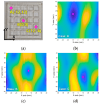Non-FFP-Based Magnetic Particle Imaging (NFMPI) with an Open-Type RF Coil System: A Feasibility Study
- PMID: 39943301
- PMCID: PMC11821019
- DOI: 10.3390/s25030665
Non-FFP-Based Magnetic Particle Imaging (NFMPI) with an Open-Type RF Coil System: A Feasibility Study
Abstract
Active drug delivery systems for cancer therapy are gaining attention for their biocompatibility and enhanced efficacy compared to conventional chemotherapy and surgery. To improve precision in targeted drug delivery (TDD), actuating devices using external magnetic fields are employed. However, a key challenge is the inability to visually track magnetic drug carriers in blood vessels, complicating navigation to the target. Magnetic particle imaging (MPI) systems can localize magnetic carriers (MCs) but rely on bulky electromagnetic coils to generate a static magnetic field gradient, creating a field-free point (FFP) within the field of view (FOV). Also, additional coils are required to move the FFP across the FOV, limiting flexibility and increasing the system size. To address these issues, we propose a non-FFP-based, open-type RF coil system with a simplified structure composed of a Tx/Rx coil and a permanent magnet at the coil center, eliminating the need for an FFP. Furthermore, integrating a robotic arm for coil assembly enables easy adjustment of the FOV size and location. Finally, imaging tests with magnetic nanoparticles (MNPs) confirmed the system's ability to detect and localize a minimum mass of 0.3 mg (Fe) in 80 × 80 mm2.
Keywords: magnetic particle imaging; non-FFP-based method; open-type MPI scanner; targeted drug delivery.
Conflict of interest statement
The authors declare no conflicts of interest.
Figures









Similar articles
-
Localization and Actuation for MNPs Based on Magnetic Field-Free Point: Feasibility of Movable Electromagnetic Actuations.Micromachines (Basel). 2020 Nov 21;11(11):1020. doi: 10.3390/mi11111020. Micromachines (Basel). 2020. PMID: 33233414 Free PMC article.
-
Optimization of Field-Free Point Position, Gradient Field and Ferromagnetic Polymer Ratio for Enhanced Navigation of Magnetically Controlled Polymer-Based Microrobots in Blood Vessel.Micromachines (Basel). 2021 Apr 13;12(4):424. doi: 10.3390/mi12040424. Micromachines (Basel). 2021. PMID: 33924499 Free PMC article.
-
Traveling wave magnetic particle imaging.IEEE Trans Med Imaging. 2014 Feb;33(2):400-7. doi: 10.1109/TMI.2013.2285472. Epub 2013 Oct 11. IEEE Trans Med Imaging. 2014. PMID: 24132006
-
RF coils: A practical guide for nonphysicists.J Magn Reson Imaging. 2018 Jun 13;48(3):590-604. doi: 10.1002/jmri.26187. Online ahead of print. J Magn Reson Imaging. 2018. PMID: 29897651 Free PMC article. Review.
-
Advancements in MR hardware systems and magnetic field control: B0 shimming, RF coils, and gradient techniques for enhancing magnetic resonance imaging and spectroscopy.Psychoradiology. 2024 Aug 14;4:kkae013. doi: 10.1093/psyrad/kkae013. eCollection 2024. Psychoradiology. 2024. PMID: 39258223 Free PMC article. Review.
References
-
- Darmawan B.A., Lee S.B., Nguyen V.D., Go G., Nguyen K.T., Lee H.S., Nan M., Hong A., Kim C.S., Li H., et al. Self-Folded Microrobot for Active Drug Delivery and Rapid Ultrasound-Triggered Drug Release. Sens. Actuators B Chem. 2020;324:128752. doi: 10.1016/j.snb.2020.128752. - DOI
Grants and funding
- 1415181807, RS-2021-KD000001/the Korea Medical Device Development Fund grant funded by the Korea government (the Ministry of Science and ICT, the Ministry of Trade, Industry and Energy, the Ministry of Health & Welfare, the Ministry of Food and Drug Safety)
- 20017903/the Ministry of Trade, Industry & Energy(MOTIE, Korea)
LinkOut - more resources
Full Text Sources

